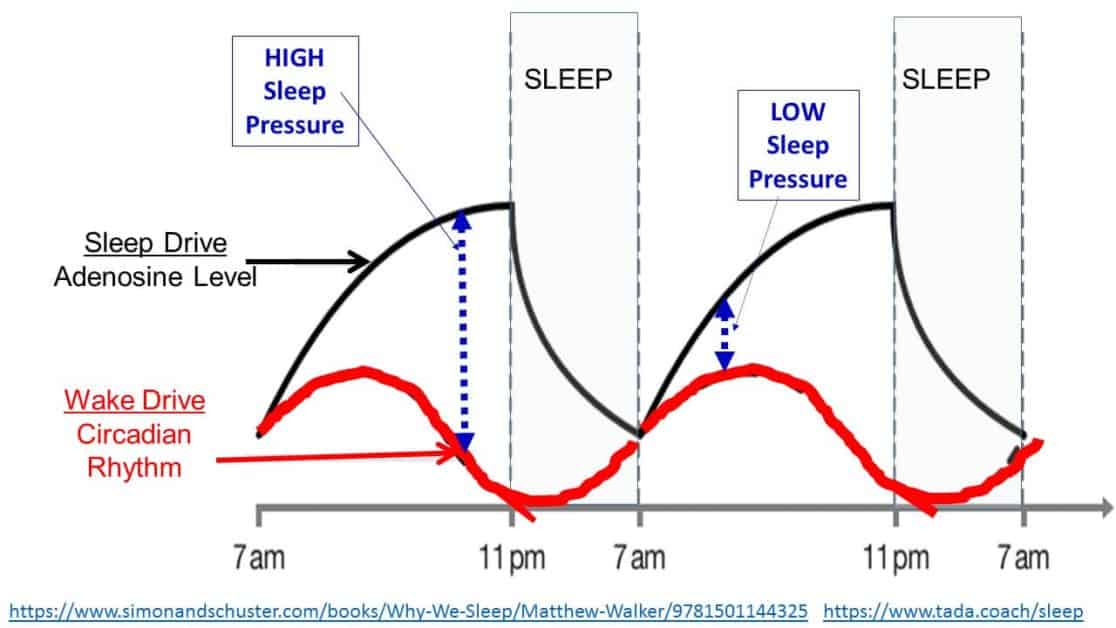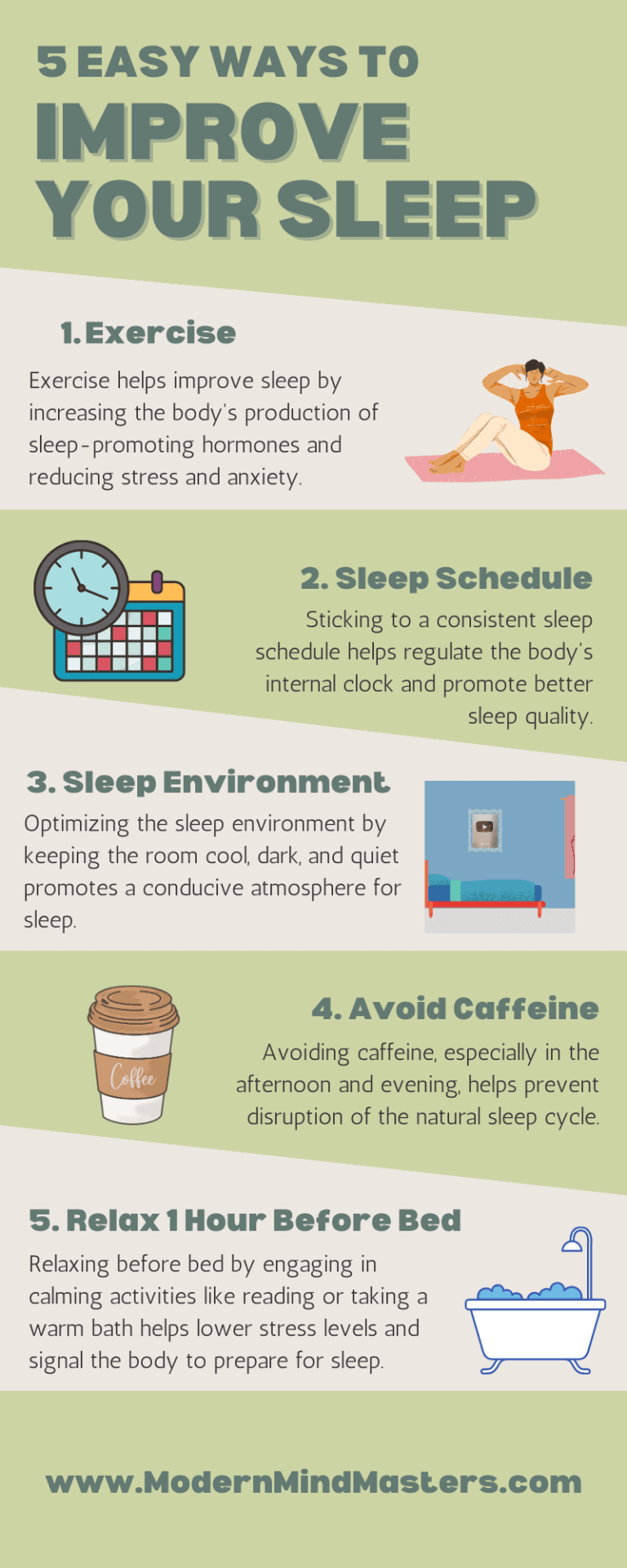The Ultimate Guide to Falling (and Staying) Asleep
Key Points:
- Melatonin and adenosine are two crucial natural chemicals responsible falling asleep, and are easily disrupted by environmental triggers.
- Exercise, sleep schedule, sleep environment, avoiding caffeine, and relaxing 1 hour before bed are 5 easy steps that should improve quality and quantity of sleep.

Jump to:
Humans spend a third of their lives sleeping, performing the same activity around the same time every single day. So why does such a natural and seemingly simple exercise turn into a nightmare for so many?
While simple on the surface, sleep involves a delicate balance of many chemical processes in the body and brain. Just one small disruption to this orchestra of sleep will throw the whole system off course, resulting in many lost hours spent tossing and turning.
This article will overview the most common causes of sleep disruption and how they affect these many sleep-based processes within the brain. We will also provide some small but significant changes you can make to your daily routine to improve your chances of falling and staying asleep.
Why is Sleep Important?
The body and brain require us to enter a state of sleep to recover, repair and revitalize from the past day’s activities. When asleep, the brain performs many cognitive processes, such as the strengthening or weakening of neural pathways and flushing the brain of unhealthy or dead cells.
Without adequate sleep, we will not just feel groggy and tired, but our physical and mental health will also suffer as the body and brain have not had enough time to build and repair vital cognitive facilities.
Oversleeping, where we find ourselves sleeping too much, has also been shown to be detrimental to health by increasing our Body Mass Index (BMI), as well as contributing to depression and mood disorders.
Why Can It Be Difficult to Sleep?
Multiple chemical processes facilitate the brain’s transition to sleep. Disruption of any of these processes can significantly impact our ability to fall asleep.
Melatonin
Melatonin is a hormone produced by the pineal gland in response to darkness. It helps to regulate the sleep-wake cycle and promotes the onset and maintenance of sleep.
Melatonin levels are at their lowest just after waking and slowly increase throughout the day until peaking in the evening before sleep. The higher the level of melatonin, the “heavier” the feeling of needing to sleep.
Melatonin is regulated by the body’s circadian rhythm, which is controlled by the suprachiasmatic nucleus (SCN) in the brain. In the presence of light, the SCN suppresses the production and release of melatonin.
This is why exposure to bright light in the evening or at night, such as cell phones or television, can disrupt the natural production of melatonin and make it harder to fall asleep.
Conversely, in the absence of light, such as in a dark room, the SCN signals to the pineal gland to produce and release melatonin, facilitating the onset of sleep.
When our melatonin levels and circadian rhythm are out of sync, the body gets confused, and sleeping becomes more difficult.
Adenosine
Similar to melatonin, adenosine, a neuromodulator in the brain, steadily increases throughout the day, contributing to the feeling of sleepiness. During sleep, adenosine levels decrease, allowing the body to feel more alert upon waking up.
Caffeine, a common stimulant, works by blocking the action of adenosine in the brain, which is why it can make people feel more awake and alert.
While adenosine helps to regulate the sleep-wake cycle by promoting sleepiness and alertness at different times of the day, melatonin helps to promote the onset and quality of sleep and is driven in response to changing light levels.

GeneticsFover
Our sleep schedules are largely driven by our genetics; some are naturally early birds (known as larks) whereas others are night owls. The variations in an individual’s natural biological predisposition to sleep and wake at certain times of day are known as chronotypes.
There is no clear consensus on what percentage of people are morning people versus evening people, as it can vary depending on how these terms are defined and measured.
One study by the University of Madrid found that around 47% of participants were morning people, 24% were evening people, and 29% fell somewhere in the middle.
Another study published in the Journal of Personality and Social Psychology found that around 40-50% of people were morning people, while 30-40% were evening people.
Although scientists are not entirely clear why sleep-wake cycles differ, one popular theory is that chronotypes may have developed as a way for humans to protect themselves from potential threats.
In the early days of human evolution, humans likely needed to take turns staying awake to protect themselves from predators during the night. This may have led to the development of different sleep-wake patterns among different individuals, with some individuals naturally preferring to stay awake later and others favoring waking up earlier.
Being a night owl is neither better nor worse than being an early bird – regardless of what time we sleep, we all have the same number of waking hours. Unfortunately for night owls, modern society norms are to wake up and work early, such as the infamous 9-5.
Working against your natural circadian rhythm, whether a lark or an owl, will often cause conflict, such as an early start forcing a night owl to sleep at 9 pm just as their body and brain are at their most alert.
Genetics, such as your chronotype, play a significant role in determining your quality of sleep. As nothing can (yet) be done to change your genetics, it is up to us to change our routine as much as possible to best work with our preferred cycles.
Medical Conditions
Many medical conditions can affect sleep. Some of the most common conditions include:
- Sleep Apnea – a sleep disorder in which a person stops breathing during sleep due to the collapse of the airway.
- Insomnia – a sleep disorder characterized by difficulty falling asleep, staying asleep, or waking up too early.
- Restless Leg Syndrome (RLS) – a condition in which a person experiences an irresistible urge to move their legs, particularly at night, which can interfere with sleep.
- Narcolepsy – a neurological disorder in which a person experiences excessive daytime sleepiness and sudden episodes of falling asleep.
- Depression and Anxiety – mental health conditions that can interfere with sleep by causing insomnia, nightmares, or hypersomnia.
These are serious conditions that will likely not be fixed without professional help from a qualified doctor. If you suspect any of the above conditions might be affecting your ability to obtain quality sleep, consult with a qualified doctor.
5 Changes to Improve Your Sleep
1) Exercise
Regular exercise has a multitude of benefits, such as improving cardiovascular health, weight management, and boosting immune health. But exercise can also help tremendously with sleep quality.
This is evident in many of the sporting elite. Floyd Mayweather, for example, claims to sleep around 10 hours a night, while LeBron James claims an incredible 12 hours a day during his training season.
Unfortunately, exercise is becoming increasingly less common. From 1988 to 2010, this study reported that the number of women who do not exercise recreationally jumped from 19% to 51% while the fraction of their male counterparts rose from 11% to 43%.
One mechanism for improved sleep quality due to exercise is believed to be its stress-relieving properties. Endorphins released during moderate activity reduce anxiety and tension by acting as natural mood elevators.
Studies also show that exercise improves sleep quality by increasing slow-wave sleep stability, the ability of the brain to maintain a consistent pattern of slow-wave activity during non-REM sleep.
Regular exercise can also help to increase the amount of time spent in deep REM sleep, the stage of sleep that is most restorative for the body, improving overall sleep quality and leaving you feeling more refreshed upon waking up.
One study demonstrated that twelve weeks of exercise training increased sleep duration and variables of sleep quality in adolescents.
These investigators found exercise training to decrease NREM stage N1 (very light sleep) while increasing REM sleep, sleep continuity, and sleep efficiency when using polysomnography.
A word of caution, however: exercise should be performed at least 1 to 2 hours before sleep, giving endorphin levels time to wash out and the brain time to wind down.
Obesity
Regular exercise (and a good diet) also improve sleep indirectly through weight and fat loss.
Excess body fat, especially around the neck and throat area, can increase the risk of sleep apnea in several ways:
- Obstructed airway: Excess fat in the neck and throat area can cause the airway to become narrowed or obstructed during sleep. This can cause breathing to become shallow or stop altogether, leading to sleep apnea.
- Increased inflammation: Obesity can increase inflammation throughout the body, including in the airways, leading to increased swelling and narrowing of the airways, making it more difficult to breathe during sleep.
- Reduced lung volume: Excess fat in the chest and abdomen can reduce lung volume, making it more difficult to breathe deeply during sleep and resulting in shallow breathing and a higher risk of sleep apnea.
- Increased demand for oxygen: Obesity can increase the body’s demand for oxygen, especially during sleep when the body is trying to repair and restore itself. This increased demand can put additional strain on the respiratory system, increasing the risk of sleep apnea.
2) Sleep Schedule
Improving our sleep schedule should focus on two parts: consistency and timing.
Timing
Create a routine that times comfortably with your chronotype. Forcing yourself to sleep from 9 pm to 5 am when you’re a natural night owl will result in poor sleep quality, efficiency, and productivity during waking hours.
The same is true the other way; forcing morning people to sleep at 2 am and wake at 10 am will result in lethargy throughout the day.
Note that both schedules result in the same number of hours spent sleeping and awake, but by working with your natural circadian rhythm, and not against it, you make better use of your time.
Consistency
Whether an owl or a lark, consistency is always crucial. Humans are, by nature, creatures of habit, and the body makes efficiencies when it learns to predict and expect things.
By sleeping and waking at the same time every day, the body begins to learn the routine and will prepare the body and brain for sleep in advance. After a few weeks of sleeping at 9 pm, for example, you will find yourself naturally preparing for sleep around 8 pm as the body knows what to expect.
The benefit here is that when you go to bed at 9 pm, you should fall asleep quickly as your melatonin and adenosine levels are naturally adjusted to peak around this time.
Unfortunately, due to modern work schedules being infamously inflexible, night owls are forced into a routine against their natural preferences. The best we can do here is to find the best compromise between schedule and consistency or find a job more in tune with your natural rhythm.
3) Sleep Environment
We’ve all had those nights where something prevents us from sleeping. Whether it be sunlight, noise, or hot and humid nights, our sleeping environments play a significant role in encouraging sustained deep sleep.
Temperature
The ideal room temperature for sleep can vary from person to person, but experts generally recommend keeping the bedroom temperature between 60-67 degrees Fahrenheit (16-19 degrees Celsius).
The effects can be subtle; my wife struggled to sleep for weeks until she simply started sleeping with socks on. This small body temperature adjustment, which she wasn’t even aware of, was enough to bring her to a comfortable state for sleeping.
If you’re having trouble sleeping, try increasing or decreasing the temperature of your environment slightly, by either wearing more/less or increasing/decreasing the ambient room temperature.
Light
Light suppresses the production of melatonin, a chemical in the brain that makes you sleepy and prepares the body for sleep. When exposed to light before sleeping, melatonin levels are suppressed and you are less likely to sleep.
Blackout curtains do an amazing job of blocking light if outside light sources are causing your problems.
Artificial light is playing an increasing role in disrupting melatonin levels and our sleep schedules. From social media on phone screens to Netflix on a TV, bright lights, combined with engaging content, disrupt melatonin levels and our ability to fall asleep.
Try removing bright light sources an hour before bed. Low light from screens is ok, but lowering the brightness as far as possible will help avoid any disruption.
Noise
Noise affects people differently; some can fall asleep in a football stadium whereas others need absolute silence.
For light sleepers, myself included, earplugs can work wonders for falling asleep. Although a little uncomfortable at first, a good quality pair will soon become barely noticeable.
For some, white noise can help tremendously by evening out sporadic noises into one smooth and gentle noise. Various apps and devices can help, although simple devices such as a fan can provide the most efficient solution.
4) Avoid Caffeine
Caffeine, one of the most widely consumed psychoactive substances, helps us overcome those moments when we’re groggy and tired. But caffeine has a longer-lasting effect on the body than most realize.
Caffeine has a half-life of seven hours, that is, half of the caffeine you ingest will still be in your system seven hours after consuming it. Any coffee, alcohol, or energy drinks consumed later than 3 pm, therefore, half still have half of its caffeine in your system by 10 pm.
Caffeine blocks the action of adenosine, a neurotransmitter that builds up throughout the day, contributing to the natural feeling of sleepiness. As a result, caffeine temporarily prevents us from feeling any more sleepy until it begins to burn away.
By blocking adenosine receptors, caffeine proves valuable earlier in the day when we want to be more awake and alert. If consumed too late, however, the same forces will prevent you from sleeping.
For some, such as myself, the effects of caffeine are much less noticeable than for others, such as my wife. While I can comfortably consume a coffee at 6 pm and have no trouble sleeping, my wife will struggle to sleep when drinking coffee past noon.
Body composition and metabolism likely play a role, but for those late-afternoon coffee lovers who struggle to sleep, bringing forward that late-afternoon brew could make a significant difference.
For decaf users, note that decaffeinated does not mean caffeine-free – a decaf coffee still contains around 5% of the caffeine as decaffeinated.
Coffee is not the only caffeine source, however: tea, energy drinks, pop, chocolate, some medications (such as pain relievers and weight loss supplements), and alcohol all contain significant enough quantities of caffeine to disrupt sleep.
5) Relax
With so much stimulation from our environment, from social media to late-night work emails, it is no wonder why we often toss and turn for hours, reliving the events of the day or planning for the next.
Take at least an hour before bed to cut yourself off from the world around you and allow your body and brain to wind down gradually.
Relaxation can come from many sources, and best of all, they are almost always enjoyable. Take a bath, watch some (not too stimulating) TV shows, or read a book. Whatever works for you, dedicate your final working hour to calming your body and mind.

Conclusion
Sleep may be simple, but it is not always easy. A combination of genetic and environmental factors can easily disrupt the delicate balance of quality sleep.
Identify whether you tend more toward being a night owl or a morning lark. Most people lie somewhere in between with a slight preference for one or the other. If possible, create a daily schedule that maximizes your productive hours, whether early or late.
To improve your sleep quality, try implementing the five changes noted above: exercise more, define your sleep schedule, optimize your sleep environment, avoid caffeine in the later parts of the day, and dedicate the hour before bed to relaxing and preparing the body for sleep.
Above all, treat sleep with the respect it deserves. Think of it like your bank account – you can’t keep withdrawing without making any deposits.

Habits Are The Foundation Of Success
Knowledge is not power without action, and habits form the consistent actions that compound over time to guarantee success.

7 Simple Habits For Consistent Change
Success stems from many small wins compounded over time – the key to this is consistency, which is achieved though the use of strong habits.

4 Ways To Increase Serotonin Naturally
Four ways to increase serotonin levels naturally include exposure to sunlight, exercise, food and diet, and supplementation.

Water Fasting – The Benefits, How Long To Fast, And How To Fast Safely
Water fasting is becoming an increasingly popular therapeutic treatment for a range of illnesses and diseases. Learn how to make a water fast work for you.

Is Saturated Fat Bad For You? The Answer Is No!
Is saturated fat bad for you? Science says no — it’s essential for health. The real danger lies in processed foods, not fat.

The 5 Best Motivational Books of All Time
Discover life-changing wisdom and strategies in the best motivational books, igniting passion, purpose, and productivity in your journey to success.